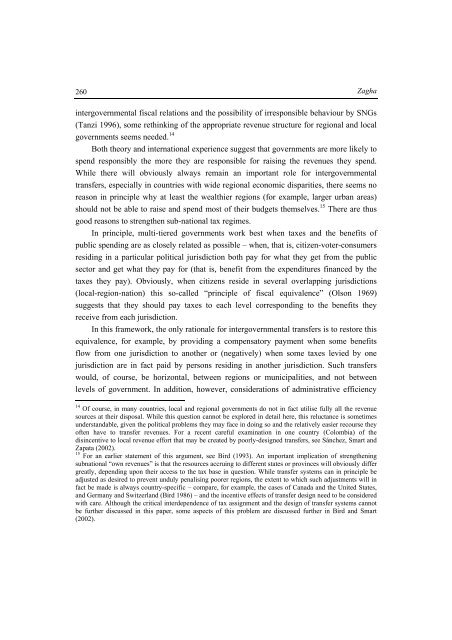The Palestinian Economy. Theoretical and Practical Challenges
The Palestinian Economy. Theoretical and Practical Challenges
The Palestinian Economy. Theoretical and Practical Challenges
You also want an ePaper? Increase the reach of your titles
YUMPU automatically turns print PDFs into web optimized ePapers that Google loves.
260<br />
Zagha<br />
intergovernmental fiscal relations <strong>and</strong> the possibility of irresponsible behaviour by SNGs<br />
(Tanzi 1996), some rethinking of the appropriate revenue structure for regional <strong>and</strong> local<br />
governments seems needed. 14<br />
Both theory <strong>and</strong> international experience suggest that governments are more likely to<br />
spend responsibly the more they are responsible for raising the revenues they spend.<br />
While there will obviously always remain an important role for intergovernmental<br />
transfers, especially in countries with wide regional economic disparities, there seems no<br />
reason in principle why at least the wealthier regions (for example, larger urban areas)<br />
should not be able to raise <strong>and</strong> spend most of their budgets themselves. 15 <strong>The</strong>re are thus<br />
good reasons to strengthen sub-national tax regimes.<br />
In principle, multi-tiered governments work best when taxes <strong>and</strong> the benefits of<br />
public spending are as closely related as possible – when, that is, citizen-voter-consumers<br />
residing in a particular political jurisdiction both pay for what they get from the public<br />
sector <strong>and</strong> get what they pay for (that is, benefit from the expenditures financed by the<br />
taxes they pay). Obviously, when citizens reside in several overlapping jurisdictions<br />
(local-region-nation) this so-called “principle of fiscal equivalence” (Olson 1969)<br />
suggests that they should pay taxes to each level corresponding to the benefits they<br />
receive from each jurisdiction.<br />
In this framework, the only rationale for intergovernmental transfers is to restore this<br />
equivalence, for example, by providing a compensatory payment when some benefits<br />
flow from one jurisdiction to another or (negatively) when some taxes levied by one<br />
jurisdiction are in fact paid by persons residing in another jurisdiction. Such transfers<br />
would, of course, be horizontal, between regions or municipalities, <strong>and</strong> not between<br />
levels of government. In addition, however, considerations of administrative efficiency<br />
14 Of course, in many countries, local <strong>and</strong> regional governments do not in fact utilise fully all the revenue<br />
sources at their disposal. While this question cannot be explored in detail here, this reluctance is sometimes<br />
underst<strong>and</strong>able, given the political problems they may face in doing so <strong>and</strong> the relatively easier recourse they<br />
often have to transfer revenues. For a recent careful examination in one country (Colombia) of the<br />
disincentive to local revenue effort that may be created by poorly-designed transfers, see Sánchez, Smart <strong>and</strong><br />
Zapata (2002).<br />
15 For an earlier statement of this argument, see Bird (1993). An important implication of strengthening<br />
subnational “own revenues” is that the resources accruing to different states or provinces will obviously differ<br />
greatly, depending upon their access to the tax base in question. While transfer systems can in principle be<br />
adjusted as desired to prevent unduly penalising poorer regions, the extent to which such adjustments will in<br />
fact be made is always country-specific – compare, for example, the cases of Canada <strong>and</strong> the United States,<br />
<strong>and</strong> Germany <strong>and</strong> Switzerl<strong>and</strong> (Bird 1986) – <strong>and</strong> the incentive effects of transfer design need to be considered<br />
with care. Although the critical interdependence of tax assignment <strong>and</strong> the design of transfer systems cannot<br />
be further discussed in this paper, some aspects of this problem are discussed further in Bird <strong>and</strong> Smart<br />
(2002).
















